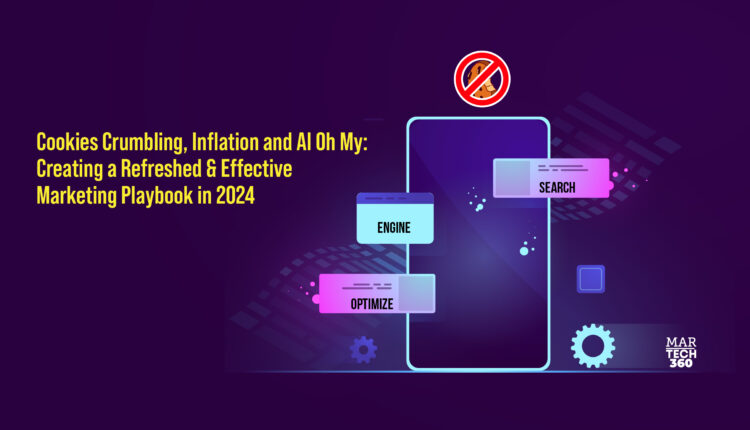Cookies Crumbling, Inflation and AI Oh My: Creating a Refreshed & Effective Marketing Playbook in 2024
Marketers have faced their fair share of challenges over the past four years. However, the confluence of multiple challenges and opportunities at once presents an unprecedented opportunity to refresh, rethink, reinvent and re-energize how brands can connect with their customers in the new year.
In InMarket’s annual Marketing Predictions survey, more than 1,100 marketers named measurement, audience targeting and third-party cookie deprecation their top 2024 challenges, predicted the rise of AI and continued growth of CTV and social commerce, and noted measurement, first-party data and omni-channel media as their top investments in the new year.
These findings pose challenges and opportunities for sure… So how can marketers best take advantage of this unique time in digital marketing in the new year?
Here are my top three recommendations to consider as you finalize your plan and build your 2024 marketing playbook:
1. Tap AI for Data Standardization, Creative Power & Personalized Sales Outreach
AI’s not just a hot industry buzz word or futuristic concept. Serious money is pouring into AI and new tools and applications are being brought to market everyday.
Thirsty VC-backed startups looking to prove their value including product/market fit and gain share means you don’t need to funnel hundreds of thousands of dollars into AI to start introducing it to your workforce and customer-facing solutions. There are several key buckets marketers can focus on to quickly and cost effectively drive business outcomes by tapping AI.
The first is data standardization. First-party data management will become increasingly critical in the cookie-less landscape for organizations of all sizes. AI presents a pivotal tool for ensuring consistency and scalability of data that can be used to inform campaign strategies, driving efficiency with a data-driven approach.
Secondly, it unlocks new potential for creative teams. The countless hours spent on searching for stock images or brainstorming copy can now be quickly eliminated with generative AI tools. Some of which are already integrated into software creative teams use everyday like PhotoShop. Not only does this improve efficiency among internal teams, it also expands revenue opportunities by cutting back on the amount of time it takes to design on creative.
Other applications include data exploration and insights to uncover new opportunities and segments that may be hidden across multiple databases, process improvements, including finding and managing contracts, and billing for greater efficiency and consistency.
Finally, AI is being put to work in sales. Leveraging public profiles, company information and more, new AI tools give marketers the ability to quickly craft customized messages to build engaging outreach efforts that can unlock significant revenue opportunities throughout the lead generation process.
Educate your team on the simple ways they can integrate these solutions and you’ll quickly see impactful outcomes.
2. Lean into Geo-Contextual Advertising
Privacy is a top priority in today’s evolving marketing landscape, creating a demand for the tactics and strategies that don’t rely on identifiers. Not only does geo-contextual advertising empower marketers to better engage customers by reaching them in precise moments of need throughout the purchase journey, it drives market leading results—generating engagement rates that average 6x the industry benchmark.
By taking a geo-contextual approach, marketers are able to go beyond just who their target customer is but understand when and where they’re making their purchase decision, which creates more personalized and meaningful experiences for shoppers without relying on identifiers.
In doing so, marketers can also leverage new insights to fuel more creatives, serving up immersive and interactive brand experiences that can drive purchase intent in the exact moment a shopping decision is being made.
Additionally, it’s essential to focus on a multifaceted approach to create a larger impact across the customer journey. Combining top-of-the-funnel audiences, CTV and DOOH alongside bottom-of-the-funnel tactics like promotions and deals, marketers can ensure consistency across every touchpoint with their target audience, simultaneously saving marketers tons of previously wasted ad dollars.
3. Better Understand Campaign Impact with Real-Time Measurement
When introducing new strategies and tactics, a learning curve is expected. As a result, it’s critical to put a comprehensive measurement program in place in order to ensure you thoroughly understand the ways your refreshed playbook is impacting business, from brand awareness to incremental visits, sales and customer loyalty.
Use the opportunity to take a step back and ensure your key KPIs still reflect the outcomes that matter most to your company. Clicks and impressions no longer cut it as the only metric for analyzing success. Your measurement strategy needs to ensure you comprehensively understand the impact of every campaign.
Finally, with the expressed concerns around the anticipated cookie depreciation from Google starting in Q1 2024, marketers must rally around the importance of maintaining a match key for digital marketing. Interoperability and addressability remain key issues that marketers must not only rally behind, but actively participate in working groups at leading industry associations like the ANA and NAI to help shape it.
2024 is shaping up to be another exciting year filled with its own share of challenges and opportunities. Accepting this fact and embracing it to refresh, rethink, reinvent your marketing approaches has the opportunity to re-energize your marketing and the way you connect with consumers to help drive growth for your organization in new and powerful ways. Happy Holidays!


Comments are closed.